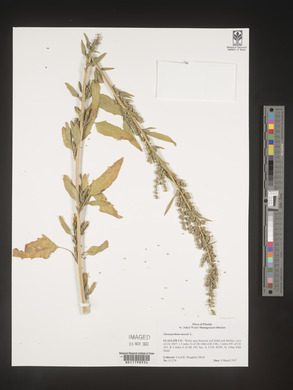Chenopodiastrum murale
|
|
|
|
Family: Amaranthaceae
Nettle-Leaf Mock Goosefoot, more...nettleleaf goosefoot (es: chual, choal (generic), hierba del perro, hediondilla)
[Chenopodium guineense Jacq., moreChenopodium longidjawense Peter, Chenopodium murale L., Chenopodium murale var. murale] |
Stems erect, branched, 1-6(-10) dm, glabrous (to sparsely farinose when young); proximal branches decumbent. Leaves nonaromatic; petiole 1-2.5 cm; blade triangular, ovate, or rhombic-ovate, 0.8-4(-8) × 0.4-3(-5) cm, base cuneate to rounded, margins irregularly dentate, apex acute to acuminate, glabrous (rarely indistinctly farinose when young). Inflorescences glomerules in terminal and lateral panicles, 6-7 × 4-5 cm; glomerules subglobose, 2-4 mm diam., or some flowers not in glomerules; bracts absent. Flowers: perianth segments 5, distinct nearly to base; lobes ovate, 0.5-0.8 × 0.6-0.7 mm, apex acute to obtuse, keeled abaxially, farinose, covering fruit at maturity; stamens 5; stigmas 2, 0.2 mm. Achenes depressed-ovoid; pericarp adherent, pustulate, becoming smooth with maturity. Seeds lenticular, round, 1-1.5 mm diam.; seed coat black, minutely rugose to ± smooth. 2n = 18. Fruiting fall. Waste places, roadsides, clay mounds, open oak woods, prairies, rocky hillsides, along railways; 0-2000 m; introduced; B.C., N.B., Ont., Que., Sask.; Ariz., Ark., Calif., Conn., Del., D.C., Fla., Ga., Ill., Ind., Ky., La., Maine, Md., Mass., Mich., Mo., Nev., N.J., N.Y., N.C., Ohio, Okla., Oreg., Pa., R.I., S.C., Tenn., Tex., Utah, Vt., Va., W.Va., Wis.; native to Europe, Asia, n Africa; introduced nearly worldwide, mostly in subtropics and warm-temperate regions. Chenopodium murale is distinctive and is one of the more common species of the genus in the world, especially in tropical and subtropical regions.
Annual herb 10 cm - 0.8 m tall Stem: upright, branched, lower branches decumbent. Leaves: alternate, on a 1 - 2.5 cm long stalk, 1 - 8 cm long, 0.5 - 6 cm wide, triangular to diamond- egg-shaped with a flat, rounded, or tapering base and pointed tip, coarsely toothed. Inflorescence: a 2 - 4 mm wide, nearly round cluster of flowers (glomerule), which together form larger, branched inflorescences (panicles) that are 6 - 7 cm long and 4 - 5 cm wide. Some flowers may not be in glomerules. Flowers: greenish, small, with five nearly distinct sepals and no petals. Sepal lobes about 0.5 mm long, egg-shaped with a blunt or pointed apex, keeled beneath, more or less white-mealy. Stamens five. Stigmas two. Fruit: one-seeded (achene), enclosed in the persistent, incurved sepals, depressed egg-shaped, thin-walled. Wall (pericarp) adherent to the seed. Seed horizontal, black, 1 - 1.5 mm wide, lenticular (lens-shaped), sharply margined, minutely wrinkled to more or less smooth. Similar species: No information at this time. Flowering: June to November Habitat and ecology: Introduced from Europe. Waste ground. Occurence in the Chicago region: non-native Etymology: Chenopodium comes from the Greek words chen, meaning goose, and podion, meaning "little foot," referring to the leaf shape of some species. Murale means "growing on walls." Author: The Morton Arboretum Felger 2000, FNA 2008 Duration: Annual Nativity: Non-Native Lifeform: Forb/Herb General: Introduced, erect or ascending, subglabrous annual 10-80 cm tall, bright green. Leaves: Leaf blades ovate to ovate-rhombic, 1.5-5 cm wide, 2.5-9 cm long, acute or obtuse, cuneate to truncate or subcordate at base, irregularly sinuate-dentate, gray scurfy farinose at least beneath in youth, soon glabrate, especially on shining upper surfaces. Flowers: In small axillary and terminal glomerules, farinose; calyx lobes oblong, obtuse, about 1 mm long, weakly carinate toward apex, incompletely enclosing fruit; greenish pericarp, closely adherent. Fruits: Seeds blackish, 1.2-1.4 mm wide, minute, devoid of dried pericarp. Ecology: Found as widespread weed of urban and agricultural areas below 9,000 ft (2743 m); flowers March-October, often other times of year. Distribution: Worldwide in the subtropics and warm temperate areas. Notes: This plant is present worldwide. Nearly impossible to distinguish from the native C. rubrum. Use geography as a guide, as C. murale is common in Arizona, particularly below the Mogollon Rim, while C. rubrum is more common in New Mexico. Also appears similar to C. album and C. berlandieri, and can be distinguished by the seeds which are sharp-edged, with irregular undulate ridges in C. murale. C. album has smooth seeds, and C. berlandieri has seeds with a fine honeycomb pattern. In general, mature seeds are necessary for conclusive identification of species within Chenopodium. Ethnobotany: Seeds were parched, ground, and eaten as pinole. Etymology: Chnopodium means goose foot, murale means growing on walls. Synonyms: Chenopodiastrum murale Editor: SBuckley 2010, 2014 Erect, branching annual to 8 dm; lvs long-petioled, deltoid to rhombic-ovate, acute or acuminate, sharply and coarsely toothed, truncate to broadly cuneate at base, sometimes a little white-mealy, to 8 נ6 cm; infls mostly axillary, divergent, branched; cal ±white- mealy, its 5 segments inconspicuously keeled on the back; seeds adnate to the pericarp, horizontal, dull black, sharply margined, 1.2-1.5 mm wide; 2n=18. Native of Europe, intr. in waste places in our range. Gleason, Henry A. & Cronquist, Arthur J. 1991. Manual of vascular plants of northeastern United States and adjacent Canada. lxxv + 910 pp. ©The New York Botanical Garden. All rights reserved. Used by permission. From Flora of Indiana (1940) by Charles C. Deam Introduced in America. ...... Indiana Coefficient of Conservatism: C = null, non-native Wetland Indicator Status: FACU Diagnostic Traits: malodorous; principal leaf blades less than 1.5 times as long as broad, coarsely toothed and lustrous above; fruiting calyx without wings or spines, covering the mature fruits; seeds sharply angled. |
|
|
|

























































































